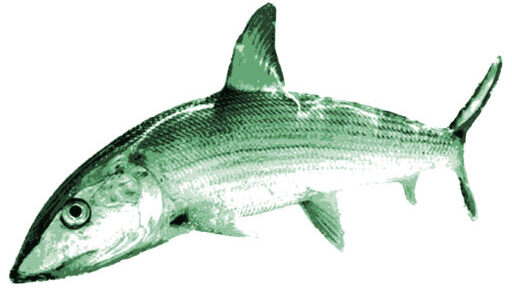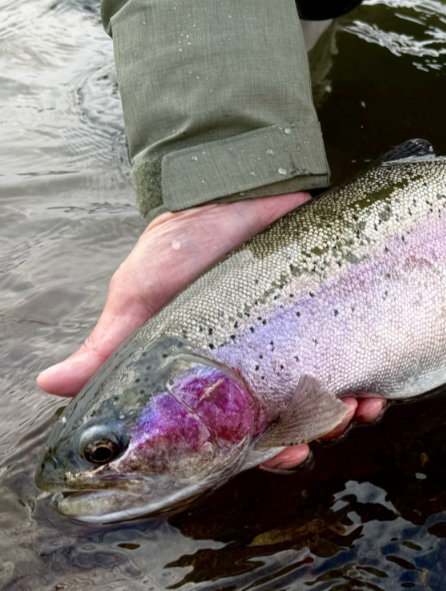
Cast Distance: 100ft/30m (Rod: 13’0″#7wt, Line: Cantam Scandi 35ft #7/8, Tip: 12′ Type 4)
11-25-2024: Scroll down for English.
この一ヶ月、私はツーハンドロッドではトラディショナル (スコティッシュ) ・スペイキャスティングでタイトなナローループでシューティングすることを特に意識している。ツーハンドロッドの場合、65ft程度の距離ならナローループを作るのは比較的容易。 しかし、100ftを越えるキャストではロッドのバット部まで曲げた上でナローループを作るのはそれなりに難しい。
ボトムハンドの急激な引き、狭いキャスティングアーク、で投げるスカンジナビアンスタイル・アンダーハンドキャスティングの場合、トップハンドはコルクハンドルの上部から1/3程に短く持ち、ロッドの回転軸の支点はトップハンドの5cm程下に持って来てキャストのストロークと共にコルクハンドルの上をスライドする。これによりボトムハンドのストロークが長いキャストが成立する。 スカンジナビアン・アンダーハンドキャスティングの有利な点は、静かに釣れる、狭いバックスペースの場所で有利、そしてタイトなナローループを作り易い、と言う点がある。 対してトラディショナル ・スペイキャスティングの場合は、トップハンドはコルクハンドルの上端(ロングロッド、ヘビーライン)、あるいは上端からグリップの1/3位の間(ショートロッド、ライトライン)に持って来て、キャスティングアークの支点はボトムハンドとトップハンドのほぼ中間地点に来る。これによりトップハンドのストロークが長くなりキャスティングのアーク(回転)角も大きくなることで、ロッドティップの移動距離もロッドにラインウェイトをローディングさせる間合いも長くなる。 スコティッシュ・スペイキャスティングの利点は、ラインにトルクが出るので風に強く、大型フライが投げ易く、遠投に有利。 よって、トーナメントキャスターの殆どはこっちの投げ方になる。 因みに、キャスティングスタイルと言えばもう一つ忘れてはならないのにパシフィックノースウェストスタイル・スカジットキャスティングがある。 こちらの利点は、シンクレートの高いシンクティップも重いフライも運べるペイロード(運搬能力)の高さが一つにある。さて、実釣向きはこの3種類のうちどれが有利か?と言う観点で言えば、それぞれのスタイルには、いずれも一長一短あって “どれがいいか” の論議はナンセンス。 この3種類の投げ方をTPOに応じて、つまり対象魚と道具と釣り場環境によって使い分けるのがトップアングラーなら目指したいところだと思う。因みにスイングフィッシング用のラインで私が最も多用するラインには、専用ティップを自由に交換できるマルチティップ・スカンジナビアン(あるいはスカンジ)があるが、これは決してスカンジナビアン・アンダーハンドキャスティング専用のラインではない。スコティッシュ・スペイキャストをしても100%その真価を発揮する。
トラディショナル・スペイキャスティングは、ロッドティップの移動距離が長く取れる分ロッドをより深く曲げることができるが、その分”ロッド・ティップパスをSLP (ストレート・ラインパス)軌道に乗せる”と言うキャスティングの基本中の基本を満たすのには工夫がいる。またストロークの最後でロッド ストップ時にカウンターフレックスがハデに出易い。これらがワイドループを生む主要因になる訳で、これらの問題を克服してタイトなナローループを投げるにはデリバリー(シューティング)・ストロークでは以下がポイントになる。
- いかに奥行きが深く、タイトだけどスラックがないD-ループが作れるか。これが上手くいけば、ロッドはデリバリーキャストの最初から十分に曲がり、ロッドティップはSLP:直線軌道を通る。キーはスイープの質と言うことになる。
- シューティングでロッドのマックスの曲がり(12時半あたり)からロッドが真っ直ぐに戻るポイント=RSP (Rod Straight Position)までは、極力時計の11時に達するまでに終えておく事。このためにはトップハンドのストロークの長さを短くし、ボトムハンドの引きはアグレッシブに入れる事。
- カウンターフレックスを極力無くす投げ方をする事。 このためにはドリフトの入れ方がキーになる。また、ストップを掛け終わったと同時にトップハンドのグリップを緩めるのがポイント。
For the past month, I have been particularly focused on shooting tight and narrow loops with Traditional (Scottish-style) Spey casting using a two-handed rod. With a two-handed rod, it’s relatively easy to form a narrow loop when casting around 65 feet, but when casting over 100 feet, it becomes somewhat difficult to flex the butt section of the rod while still maintaining a tight and narrow loop.
In Scandinavian-style Underhand casting, which involves a sharp pull with the bottom hand and a narrow casting arc, the top hand is placed about one-third of the way down from the top of the cork handle. The pivot of the rod’s rotational axis is located about 2 inches below the top hand, which actually slides during the casting stroke. This allows for a long bottom-hand casting stroke. The advantages of Scandinavian Underhand casting are its quiet presentation, effectiveness in tight backspace situations, and the ease with which tight, narrow loops can be formed.
In contrast, in Traditional Spey casting, the top hand is placed at the top of the cork handle (for long rods and heavy lines), or between the top and one-third of the way down (for shorter rods and lighter lines). The pivot of the casting arc lies roughly midway between the top and bottom hands. This configuration allows for a longer top-hand stroke and a wider casting arc, which in turn results in a longer rod tip travel and more line loading. The advantages of Traditional Spey casting include greater torque in the line—making it more wind-resistant—ease in casting large flies, and suitability for long-distance casting. This is why most tournament casters prefer this style.
Incidentally, another style worth mentioning is the Pacific Northwest-style Skagit casting. Its primary advantage is its high payload capacity, allowing it to carry both heavy sink-tips and large flies.
As for which style is more advantageous in actual fishing, each of the three casting methods has its own pros and cons. Therefore, it’s meaningless to argue which is “better.” I believe that top anglers should be capable of using all three casting methods depending on the target species, gear, and fishing conditions.
Incidentally, the line I most often use for swing fishing is the interchangeable multi-tip Scandinavian line (commonly referred to as “Scandi”), which allows for easy swapping of dedicated tips. However, it is by no means exclusive to Scandinavian underhand casting—it performs excellently in Scottish-style Spey casting as well.
In Traditional Spey casting, the longer rod tip travel enables deeper rod loading, but achieving the most basic casting principle—keeping the rod tip on a Straight Line Path (SLP)—requires some finesse. Also, stopping the casting stroke often results in noticeable counter-flex, which can lead to wider loops.
To overcome these challenges and form tight, narrow loops, particularly during the delivery stroke, keep the following key points in mind:
- Create a deep, tight D-loop without slack. If done correctly, the rod loads fully at the beginning of the delivery cast, and the tip follows an SLP. The sweep quality is crucial here.
- During the shooting phase, aim to complete the motion from maximum rod bend (around 12:30) to Rod Straight Position (RSP) by 11 o’clock. Shorten the top-hand stroke while aggressively pulling with the bottom hand.
- Minimize counter-flex during the cast. This can be achieved through the way you drift the rod after the stop, and by relaxing your grip on the top hand immediately after stopping the rod.


